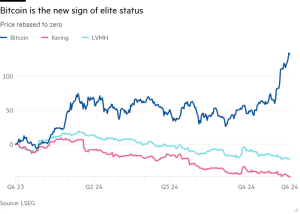Ireland is awash with cash but needs an infrastructure vision
Unlock the Editor’s Digest for free
Roula Khalaf, Editor of the FT, selects her favourite stories in this weekly newsletter.
Ireland is awash with cash from record surpluses, but a failure to deliver major infrastructure despite extravagant spending has sparked a painful question: does the EU nation have more money than sense?
Nine years after planning permission was lodged for a new national children’s hospital in Dublin, the facility has yet to open and its cost has more than tripled to €2.2bn, more than the $1.5bn cost of the 163-floor, Burj Khalifa skyscraper built in 2010 in Dubai (even after adjusting for inflation).
The hospital’s completion date has shifted 14 times in the last year alone as the health minister accused the builder of seeking to “extract as much money from the Irish state as possible” — a claim the builder rejected as “misleading, ill-informed and incorrect”.
Meanwhile — despite struggling to meet the housing, energy, water and transport needs of its fast-growing population and economy — the government built a €335,000 open-sided shelter for 18 bikes at Ireland’s parliament and a €1.4mn security entrance to government buildings.
Ireland is no stranger to splashing the cash in times of plenty — there is even an Irish word, flaithúlach (pronounced “fla-hoo-lock”) — for the kind of lavish excesses that ended up bankrupting the country a decade-and-a-half ago with reckless lending in a property boom.
Ireland’s problem now is manifestly not money: it has grown rich on the investment of multinational tech and pharma companies and is expecting a €24bn budget surplus this year. What Ireland Inc needs, experts say, is a vision.
“Ireland could really do with another TK Whitaker-type plan,” said Liam McCabe, chair and head of projects and construction at leading Irish law firm William Fry, referring to the influential public servant whose 1958 paper “Economic Development” laid the foundations for Ireland’s decades of foreign direct investment-focused expansion. Indeed, its failure to provide 21st century infrastructure risks turning off the very investment on which it now depends.
Past economic crises meant Ireland long exported its people. Now it is struggling to catch up on the infrastructure needs of its expanding population amid labour constraints from nearly full employment.
“When you’re nouveau riche and you’re suddenly having to do these big construction [projects] in an otherwise services-based economy, it’s hard to do the low productivity things well because they haven’t been the focus,” said Kevin Timoney, chief economist at Davy, a brokerage.
Planning bottlenecks are also a hurdle: legislation to speed up decisions received parliamentary approval on Wednesday but few expect it to prove a panacea. Dublin airport, the country’s main gateway, is being forced to slash seat availability — costing the economy millions — as it awaits a decision on loosening what it calls an “outdated” cap on passenger numbers.
“This is no longer just an airport or planning issue,” Kenny Jacobs, chief executive of airport operator DAA, said this week. “It is now an Ireland issue.”
Ireland’s population, now 5.4mn, has nearly doubled since Whitaker’s day and the country is so deep into a housing supply crisis that the central bank estimates it needs to build 52,000 homes a year, every year, for the next quarter of a century, just to keep up with demand — about a 50 per cent increase on this year’s official target.
Water and transport projects, including a metro to Dublin airport, have been stuck for decades. Ireland has no shortage of wind yet an offshore renewable energy industry has yet to take off.
Taoiseach Simon Harris has floated creating a new infrastructure ministry but the Irish Fiscal Advisory Council, an independent watchdog, says Ireland requires a “serious vision that delivers on the economy’s needs without repeating the boom-to-bust pattern of its past”.
In contrast to the lavish cost of the children’s hospital, JD Buckley, chief executive in Ireland of TV, broadband and mobile phone company Sky, highlights the national broadband plan. “It got off to a slow start but it now has good momentum with the rollout progressing on budget and on schedule,” he said. The government is targeting €2.6bn to deploy 100,000km of fibre and connect 1.1mn people by the end of 2026 but National Broadband Ireland is “confident” it will come in under budget. To keep it on track, it has to meet 500 milestones to unlock the subsidy.
The country has become “a bit complacent in its economic success”, according to McCabe. “Ireland needs to revisit its business plan and make some bold decisions.”
#Ireland #awash #cash #infrastructure #vision




